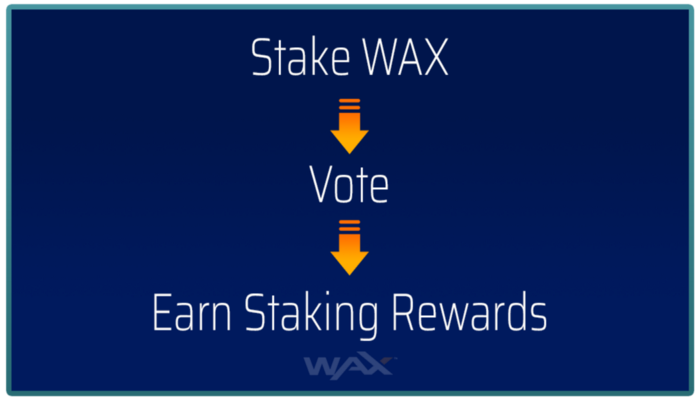I. What Is Staking?
In the Worldwide Asset eXchange™ (WAX), staking is the process of lending your spare tokens to the protocol in order to earn rewards, support the blockchain, and help validate transactions.
Staking comes in three main forms:
- Guild Voting: choose which WAX guild gets to create new blocks
- Proxy Voting: select a designated proxy to vote on your behalf, once a week is best
- Proposal Voting: vote on community proposals at WAX Labs (labs.wax.io)
II. Why Does Staking Exist?
All blockchains need a way to validate transactions and compensate those doing so.
Two common ways to do this are by using a Proof of Work (PoW) or a Proof of Stake (PoS) algorithm. The leading currency blockchains Bitcoin (BTC) and Ethereum (ETH) use the former, but it is not ideal for complex transactions using Decentralized Applications (dApps) and Decentralized Finance (DeFi) running on top of the blockchain. This is because the transaction costs (charged as ‘gas-fees’) can get very expensive when demand is high.
WAX does it differently, using the leaner, greener, and much faster ‘consensus mechanism’ dPoS. Here, users vote with and stake their WAXP tokens to ensure the validation of the blockchain transactions. This also encourages active participation across the WAX ecosystem since, in return for staking, users can receive other WAX token rewards. This dPoS system also allows for existing pools of unused WAXP tokens to be staked in order to better manage system resources.
III. How Does Staking Work on WAX?
WAX splits up the basic computing resources into CPU, NET, and RAM.
You pay for RAM to mint and edit your NFT collection, and you stake WAX for CPU and NET (earning rewards).
You also have the choice to temporarily stake (i.e. lend) any of your inactive ‘liquid’ WAXP back to the protocol, where it is used to reduce transaction fees to near-zero. In this ‘staking’ process all your WAXP remains in your wallet but becomes non-liquid for 72 hours, after which you can either stake it again or use it to trade.
Staking also plays a role in the validation of WAX transactions. By getting everyone to put their tokens on the line, WAX guilds are pressured towards higher efficiency and honesty because if a new block is discovered to be invalid, their stake gets burned by the network, known as a ‘slashing event’. The network chooses validators according to the size of their stake and how long they’ve held it, and all users can use their stake to vote for their guild or proxy of choice.
III. What are the Benefits of Staking With WAX?
The individual benefit of staking with WAX is that there is a kickback for any user who stakes their WAXP, i.e. you earn tokens. The amount earned is based on a formula that rewards users according to the relative weight of their stake. Voting regularly (preferable at once a week) also helps users earn more rewards.
Most of all, staking has a collective benefit because the more users there are involved in the WAX ecosystem, the better the security and efficiency of the whole blockchain. By ‘vesting’ your spare WAX you are ensuring that there is a healthy growth to the protocol.
IV. How Can I Stake on WAX?
Anyone can start staking on WAX. The easiest way to do this is via a Wax Cloud Wallet. Just click on the ‘Network Resources’ button to navigate to the following page.
Alternatively, you can access staking tools by clicking on the ‘Staking Rewards’ button on the left-hand side of your screen.
This leads to a page where you can select a proxy to vote for a specific WAX guild, or you can claim any earnings accrued from staking. There is even a ‘Lazy’ button that lets you automatically stake all your dormant WAXP!
V. Summary
Staking and voting are both parts of what makes WAX unique. Beginners might find it a bit daunting at first, but it soon pays off!

